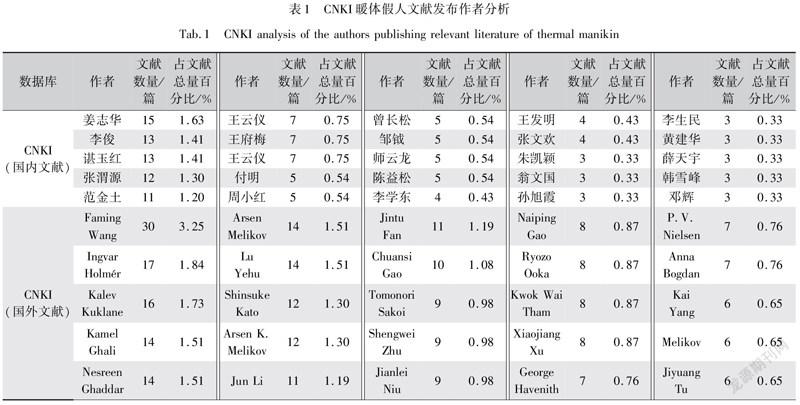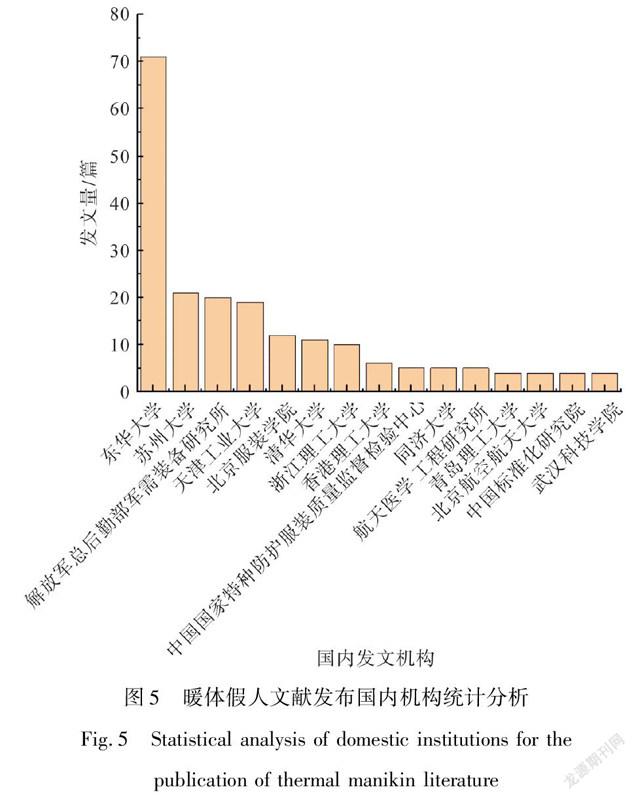基于文献分析的暖体假人研究进展
2022-05-25叶翔宇张惠芳曹丽勤卢晓旺麻可爱唐孝芬
叶翔宇 张惠芳 曹丽勤 卢晓旺 麻可爱 唐孝芬








摘要: 为探讨暖体假人的研究进展与未来发展趋势,本文以中国知网文献数据库、Web of Science为数据来源,收集并统计了暖体假人相关文献,并基于分析文献的发文量、关键词、机构等信息进行可视化分析,探究了暖體假人的研究现状,表征了当前暖体假人技术的相关研究热点、研究现状,以及分析了未来的发展趋势。基于文献分析,研究认为暖体假人经过三代迭替,目前研究热点是非均匀出汗暖体假人的研制,未来需更好地模拟真人状态,则需要从测试方法进一步标准化,测试系统性能的计量校准规范进一步核查等领域展开研究。
关键词: 暖体假人;可视化分析;研究热点;研究现状;发展趋势;标准化
中图分类号: TS941.19文献标志码: A文章编号: 10017003(2022)05006809
引用页码: 051110DOI: 10.3969/j.issn.1001-7003.2022.05.010
暖体假人是通过对真人的体表产热、四肢关节运动、体表出汗等生理活动或特征对真人的着装情况进行模拟,从而更为真实有效地反映特定服装的服用性能,是目前测量服装热湿性能最为精准有效的方式。通过暖体假人评价方法能有效测量服用纺织品的热阻和湿阻,其精确度高、可重复性强的特点使其在服装服用性能测试上成为了不可缺少的有效工具[1]。
目前,国内外关于利用暖体假人技术对服装热湿舒适性的测量方法大多还停留在静态测量阶段,测试标准有GB/T 35762—2017《纺织品热传递性能试验方法平板法》和GB/T 11048—2018《纺织品生理舒适性稳态条件下热阻和湿阻的测定(蒸发热板法)》。因此,采用动态精准测量的暖体假人技术可以大幅提升热湿舒适性结果的准确性,以更为精准的方式表征人体在动态情况下,“服装-人体”环境之间的热湿性能变化。目前为止,针对暖体假人发展进程进行跟踪和分析的文献还很少,对于暖体假人的研究进展整体把握上还存在不足,这对于了解暖体假人的研究现状和发展前景不利。
基于上述情况,本文利用高级检索方式选取了中国知网文献数据库(CNKI)和Web of Science(WOS)中与暖体假人相关的文献进行了研究。先利用主题检索方式对相关文献进行检索,对暖体假人各类文献的作者、发文机构、发表年份、关键词等信息进行梳理分析,探究暖体假人的研究历程、当前研究现状和未来研究趋势,以期为暖体假人的进一步研究提供借鉴。
1数据来源及研究方法
1.1数据来源
本文采用了中国知网文献数据库(CNKI)和Web of Science(WOS)高级检索路径下与有关暖体假人研究的文献作为统计数据来源。以“暖体假人”为检索词,进行主题和题目的文献搜索,检索策略为:主题%=’暖体假人’ or 题名%=’暖体假人’ or title=xls(’暖体假人’) or v_subject=xls(’暖体假人’)。检索周期为1950年1月—2021年10月,剔除会议通知、投稿指南及与主题不符等无效文献后,CNKI检索出暖体假人的相关文献总数为923篇,WOS检索出暖体假人的相关文献总数为903篇,本文以此作为研究内容。
1.2研究方法与工具
知识图谱能够以可视化的图像结构与数据参数表现出特定知识领域的知识结构与历史进程,避免数据单调性影响对文献价值的估量[2]。本文主要涉及以下研究方法:1) 发文量统计,主要描述当前在暖体假人领域中已经存在的研究情况;2) 作者分析,主要描述在暖体假人领域,哪些专家已经获得了较为丰硕的研究成果;3) 关键词统计,主要描述在与暖体假人相关的研究当中,哪些参数或领域是具有高度相关性的;4) 发文机构统计,描述不同机构在暖体假人方面研究的统计。本文采用的分析软件是VOSviewer。
2暖体假人研究的可视化分析
2.1发文量分析
本文对暖体假人相关的文献发表进行了统计分析,并绘制了对应的走势图(CNKI发文量如图1所示,WOS发文量如图2所示)。
从CNKI和WOS发文量统计中可知,从1956年开始到2000年,暖体假人的相关文献的发表量还是处在非常缺乏的阶段,每年发表量不到20篇,主要是在2000年之前,纺织品检测技术还处在静态检测的研究阶段。进入21世纪,随着世界各国对于纺织品检测技术的逐步深入,以及对动态检测的暖体假人技术的研究加深,暖体假人技术也逐渐步入检测专家的视野,暖体假人的相关研究有了明显的增长趋势,几乎每年都有超过25篇的文献被发表,并在2016年达到91篇的顶峰。相关文献的大量发表,有助于为后续学者提供更为丰富的理论技术和实践指导。暖体假人的研究正处于蓬勃发展阶段,知识储量正不断增长,为该领域的发展奠定了扎实基础。但是2017年开始,关于暖体假人的文献量有所下降,可能原因之一是暖体假人已经从学术界慢慢推广应用到产业界。
2.2作者分析
通过对已发表文献的作者进行分析,可以更好了解在暖体假人领域中的核心人物,并根据核心学者的研究方向来确定暖体假人的研究重点和未来发展趋势。本文将暖体假人相关文献的作者进行了汇总,如表1、表2所示。
随着时间的递进,越来越多的学者也开始关注并研究暖体假人技术,并将暖体假人应用到包含纺织品检测、特种服装、特种环境检测等多种方面[3-6],多场景的应用使得暖体假人的相关研究从20世纪以来整体以正向的趋势在发展。至2021年10月,姜志华发表的中文文献数量最多,共15篇,占CNKI总发表数量的1.63%,其次是李俊、谌玉红。姜志华和谌玉红主要研究暖体假人的测控原理,通过改进热控制系统,增加暖体假人的仿真效果[7-10];王发明发表的外文文献30篇,占CNKI总发表文献的数量最多,同时在Web of Science中的文献高达72篇,占总文献总数量的8.00%,是发表暖体假人相关文献量最多的学者,主要研究开发运动型暖体假人,模拟运动状态和环境对人体出汗生理反应的影响,并探究暖体假人的应用[11-16]。排名第二的学者李俊主要研究暖体假人的传热特性,通过暖体假人测试数值评价服装的热调节效果[17-19]。由表1可得,近年来中国学者的关于暖体假人的研究量高于国外学者,表明中国学者对暖体假人的研究高度和范围处在国际前沿,对国内甚至国际纺织品的研究检测都产生深远影响。由此可见,近年以来暖体假人技术受到了广大学者的重视,也有越来越多的学者将研究重点放在了暖体假人的研究及其应用上,随之而来的结果就是相关的文献得到了充实,暖体假人在各个领域上的应用也得到了扩展。
2.3关键词统计
文献的关键词体现了该篇文献的主要研究重点和涉及领域,阐述了该篇文献的主要研究对象,通过进行关键词分析,可以确立文献的主题[20]。本文通过将暖体假人相关文献进行汇总后,将文献中涉及到的关键词进行统计汇总,并以频次高低的形式将不同的关键词进行排序(表3),最后通过VOSviewer根据关键词的频次创建了对应的知识图谱,以更为可视化的方式来表征不同关键词在暖体假人的相关研究中的相关程度和重要程度(图3)。
从表3关键词频次统计分析和图3知识图谱中可以看出,thermal manikin(暖体假人)、thermal comfort(热舒适性)、thermal insulation(隔热)、热阻、湿阻、protective cloth(防护面料)等是出现频次较高的关键词。从总体而言,热湿舒适性仍然是暖体假人研究的重点。其中包括热阻、湿阻等热湿舒适性的相关参数在暖体假人的相关文献中出现频次较高。同时一些占比较低的关键词,例如protective cloth(防护面料)、呼吸流动等,也表明了暖体假人的相关研究开始有了新的拓展:暖体假人的相关研究不仅局限在服装用纺织品上,而同时也被拓展到防护纺织品、特种纺织品上;且为了更好地模拟人穿着衣服的实际情况,出汗暖体假人的研究也愈发增加,更新了暖体假人的技术参数和应用场景。
2.4发文国家及国内机构分析
对文献发表的国家和国内机构进行分析,能够描述暖体假人研究领域中的科研力量分布。本文列举了暖体假人相关领域中文献发表量前十五位的国家和国内科研机构,并按发文量从多到少的顺序进行排列(图4、图5)。
由图4可见,在研究暖体假人方面,中国处于领先位置,共发文330余篇,其次是美国;对国内发文机构数量统计,国内的纺织类或理工类学校研究的较多,这类科研机构在纺织类研究上都有较为卓越的成树,排名第一的机构为东华大学,总计71篇相关文献,其次是苏州大学。通常这类科研机构是将暖体假人作为纺织品性能的测试工具或手段进行使用。同时,还有一些其他性质的科研机构,如北京航空航天大学及中国航天员科研训练中心,该类科研机构主要的研究涉及在极端环境下的特种服装性能的检测,利用暖体假人进行极端环境的研究。
3暖体假人研究进展
3.1迭代进展综述
目前,国内外的众多研究机构为了更好地研究暖体假人的技术革新历程,展开了对暖体假人自研发开始各个版本迭代的研究。这些研究汇总了国内外不同版本的暖体假人技术的优缺点、创新点及背后的研究思路。
暖体假人的发展历程可以划分为三个阶段[21]:初代的暖体假人为单段式,适用范围较小,仅能用于纺织品的静态热阻测试[22];第二代的暖体假人采用了多段式的形式,即假人具有多个部分可以单独控制、加热,且躯体可以进行简单的姿势调整,能够模拟服装穿着的静态热阻与动态热阻;第三代暖体假人模拟了人体的出汗功能,且各个肢体能够实现更加精细的肢体运动,可对服装的热阻、湿阻进行综合评价。
为了更好模拟人体在着装时的热湿舒适性,暖体假人的出汗方式经过了多次的迭代[23]。从最开始的外部喷水模拟出汗效果,再到外部管道供水、内部管道供水,模拟出汗的方式也越来越与正常人体出汗效果相似。张超等[24]利用暖体假人“NEWTON”模拟了高温环境下人体体温和出汗率的变化,并从体温过高、出汗脱水两个维度判断人体的安全状态。该实验通过在假人皮肤层下植入内置体内控制器与毛细管,模拟人体出汗的微单元,以及外在的控制箱模拟人体脏器的活动,精确地表征了在高温环境下人体作业的产热、出汗水平。在实际生活中,人体不同部位的出汗量不同,因此模拟人体的非均匀出汗成为了重点[25]。王发明等[26]研制的自适应(或温度调节模型控制)人体模型在量化人体服装-环境系统的热交换和模拟人体热生理行为方面非常有用,建议在适应性人体模型上模拟人类活动时,应考虑身体运动。为了更好地模拟人体的非均匀出汗过程,师云龙等[27]采用硅胶涂层制备了非均匀出汗皮肤,并且将非均匀出汗皮肤与均匀出汗皮肤进行了热湿性能测试对照,结果表明非均勻出汗皮肤在热阻、湿阻的结果上均有显著提升。2021年,日本的Nagasawa[28]研究开发了一个附加的局部出汗模拟系统,将现有的暖体假人升级为局部出汗暖体假人,类似于人躺在有通风床垫的床上。
3.2应用现状
暖体假人作为测量纺织品热湿舒适性的重要工具,在各类研究中常被用于测量不同类型纺织品的热湿舒适性,包括服用纺织品、特种服装纺织品等,也必将更好地服务于功能性服装如防极寒天气服装、辐射制冷服装等的开发和应用[29-31]。
暖体假人在特种纺织服装领域方面的应用上,由于太空环境的复杂因素众多,外界环境因素及工作内容会对宇航员产热产生影响,人体的产热活动又是一个复杂的控制过程。为了准确表征在太空中宇航员的热调节模型,陈尧等[32]利用暖体假人进行太空环境宇航服的热湿性能测试。在日用服用纺织品上,暖体假人技术同样也起到了重要作用。吴芷琼等[33]提出,在传统的恒温法、冷却法测试保暖内衣的保温率之外,还可以利用暖体假人技术测量保暖内衣的保温率。
除了现有的暖体假人技术,许多的研究者将目光放在暖体假人的功能提升上。目前常用的暖体假人主要模拟了人体的行走运动、发热过程及出汗过程,对其他的生理活动模拟较少。刘雅琳等[34]为了模拟人体内部的微环境系统,再现人体从外部环境吸入飞沫及飞沫在呼吸道中停留的过程,设计了一种新型的呼吸暖体假人。通过设计“理想呼吸道”模拟还原了飞沫核在呼吸道中的暴露程度,该种假人可模拟多种程度的代谢过程,较好地替代真人的呼吸过程。
3.3未来发展趋势
当前的暖体假人设备虽然在肢体运动、模拟出汗、模拟呼吸等方面已经可以在一定程度上比拟真人的生理活动,但是与真实的生理活动还存在一定差距。因此,在利用暖体假人技术得到的热湿性能数据时,还需要结合其他因素综合评判。为更好地模拟正常人体的生理活动,暖体假人今后的研究主要可以从以下几个方面开展。
3.3.1加深研究人体出汗非均匀分布的功能
当前暖体假人的出汗形式为均匀出汗,各个肢体的出汗量均相同,但是在人体生理活动中,人体的各个部位出汗量存在差异,并非均匀分布,尤其在背部、腋下、胸部等部位出汗量较多。雷中祥等[23]采用涂层技术实现了简单的非均匀出汗,但是与真实人体出汗情况仍存在差异。因此,需要完善暖体假人的非均匀出汗系统,更加切实地反应人体的出汗情况,提升热湿舒适性检验的精准性。
3.3.2实现对暖体假人的局部热湿性能测量
目前的暖体假人在计算热湿舒适性时只能从整体计算,局部的热湿阻测量研究较少。测量局部范围的热湿阻能够更加精确地表征特定部位的保温、透湿性能,以计算服装的局部热湿舒适性,从而实现对服装整体结构性的理解及设计[35]。
3.3.3完善测试原理及测试标准
目前国内标准有2020年提出的GB/T 39605—2020《服装湿阻测试方法暖体假人法》,对出汗暖体假人的热阻、湿阻的测量方法进行了规定,但是该标准主要适用于稳态、直立的暖体假人,其他身体姿态或是存在环境影响因素的暖体假人测试只能参照该标准进行测试。同时全球范围内有许多不同类型的出汗暖体假人,其采用的数据参数及出汗方式都不同,因此采用不同类型的暖体假人可能会产生结果的差异。用暖体假人测量服装隔热性能的国外标准有ASTM F 1291、ISO 9920—2007和ISO 15831—2004。然而,只有一个标准ASTM F2730—10测试服装的蒸发阻力,它只描述了热人体模型的尺寸、测试条件和程序,没有确定暖体假人冒汗的方法。因此,不同的暖体假人模型可以采用不同的方法模拟出汗,而且出汗量的设定没有明确的规则[4]。综上,暖体假人的测试原理及测试标准仍需完善,暖体假人测试系统目前缺乏计量校准规范。
3.3.4加深服装结构参数与热湿性能研究
应用暖体出汗假人系统进行大量服装样本的测试,建立服装结构参数与热湿性能指标的标准关系数据库和预测模型,以及科学合理地制定服装热湿性能测试标准,为假人系统及测试技术的标准化、通用化和市场化提供条件。
3.3.5研究假人与服装之间的服装内气候
在暖体假人模拟人体运动过程中,暖体假人与服装之间存在着服装内气候,外界环境的状态及体温调节、运动等人体状态、服装的原料及厚度等因素均会影响服装内气候[22]。因此,不仅要参考从服装外部信息得到的热湿性能,也要设计能研究服装内部与暖体假人皮肤之间的服装内气候性能的系统设备。
3.3.6开发出新型汗暖体假人皮肤材料
早期的暖体假人为了发热功能,均采用了金属作为皮肤表层,但是由于金属比热容较小,导致假人皮肤散热较快,无法保证皮肤表层的稳定与均匀。之后迭代的假人采用了织物皮肤,可以避免假人皮肤快速散热的缺点,但是织物制成的皮肤缺乏人体皮肤的弹性和柔韧性,在测试特定服装时仍存在差异。因此,为暖体假人制造一种具有较高比热容和较好伸缩性的皮肤材料仍是当前的研究重点。
3.3.7采用无线方式数据传输
当用暖体假人测试服装的热阻或湿阻时,由于控制电缆通常从头部或颈部引出,操作者不得不将头饰沿中间剪开,待穿上后再缝上,这些都会影响测试结果。未来的暖体假人和外部控制系统的数据传输,可以通过无线方式来实现,这也便于将暖体假人用于室外的现场测试。
4结论
采用暖体假人测试系统进行成衣性能测试,是服装行业开展舒适性研究的发展趋势。本文通过VOSviewer软件分析了发表在中国知网和Web of Science上的“暖体假人”论文,发现中国是暖体假人发文量最多的国家,其中东华大学是国内发文量最多的研究机构。暖体假人测试系统因可应用于宇航服、防护服等军工航天领域,故热湿舒适性和防护面料是该领域研究的关键词热点。随着相关测试方法标准的研制发布,2017年开始发文量有所下降,并在产业界开始逐步推广应用。
目前暖体假人测试系统已经研发到第三代,未来的研究关键主要在假人仿真出汗、表面材料仿真皮肤、控制系统拟人化行走等方面。高度拟人化的假人需要搭配高度真实化的气候室,才可以更准确、可重復性更高地评估特种服装热湿舒适性。此外,还需要同步研制配套的暖体假人测试系统计量校准规范,采用量值溯源建标的方式来确保系统测试数据的准确性。
参考文献:
[1]谌玉红, 姜志华, 曾长松. 暖体假人测试技术研究现状与发展趋势[J]. 北京纺织, 2000(3): 49-51.SHEN Yuhong, JIANG Zhihua, ZENG Changsong. Research status and development trend of sweating thermal manikin testing technology[J]. Beijing Textile Journal, 2000(3): 49-51.
[2]王雪梅, 张志强, 李新. 基于知识图谱和GIS分析的国际青藏高原研究态势分析[J]. 情报学报, 2015(9): 930-937.WANG Xuemei, ZHANG Zhiqiang, LI Xin. Tendency analysis of the international studies of Qinghai-Tibet plateau using MKD and GIS[J]. Journal of the China Society for Scientific and Technical Information, 2015(9): 930-937.
[3]KRUCINSKA I, SKRZETUSKA E, KOWALSKI K. Application of a thermal mannequin to the assessment of the heat insulating power of protective garments for premature babies[J]. Autex Research Journal, 2019, 19(2): 134-146.
[4]LEI Zhongxiang. Review of application of thermal manikin in evaluation on thermal and moisture comfort of clothing[J]. Journal of Engineered Fibers and Fabrics, 2019(14): 1-10.
[5]张文欢, 钱晓明, 范金土, 等. 人体出汗率分布的研究进展[J]. 纺织学报, 2018, 39(8): 179-184.ZHANG Wenhuan, QIAN Xiaoming, FAN Jintu, et al. Research progress on the distribution of human sweating rate[J]. Journal of Textile Research, 2018, 39(8): 179-184.
[6]赖军, 许静娴, 陈立丽, 等. 服装动态热阻测定及预测模型的研究进展[J]. 纺织学报, 2017, 38(5): 170-176.LAI Jun, XU Jingxian, CHEN Lili, et al. Research progress of clothing dynamic thermal resistance measurement and prediction model[J]. Journal of Textile Research, 2017, 38(5): 170-176.
[7]谌玉红, 姜志华, 曾长松. 暖体假人直流程控电源的研究与应用[J]. 纺织学报, 2005(1): 102-103.SHEN Yuhong, JIANG Zhihua, ZENG Changsong. Study and application of program-control DC power for thermal manikin[J]. Journal of Textile Research, 2005(1): 102-103.
[8]諶玉红, 姜志华, 倪济云, 等. 暖体假人恒温控制软件设计[J]. 纺织学报, 2004(3): 105-107.SHEN Yuhong, JIANG Zhihua, NI Jiyun, et al. Design of constant temperature control software forthermal manikin[J]. Journal of Textile Research, 2004(3): 105-107.
[9]姜志华, 谌玉红. 暖体假人模拟人体热反应测控模型的研究[J]. 中国个体防护装备, 2001(5): 14-16.JIANG Zhihua, SHEN Yuhong, Study on measurement and control model of human thermal reaction simulated by thermal manikin[J]. China Personal Protective Equipment, 2001(5): 14-16.
[10]谌玉红, 姜志华, 曾长松. 暖体假人的测试原理及应用[J]. 中国劳动防护用品, 2000(4): 33-35.SHEN Yuhong, JIANG Zhihua, ZENG Changsong. Test principle and application ofthermal manikin[J]. China Labor Protection Articles, 2000(4): 33-35.
[11]WANG Faming. Effect of body movement on the thermophysiological responses of an adaptive manikin and human subjects[J]. Measurement, 2018, 116: 251-256.
[12]WANG Faming, KALEY K, GAO Chuansi, et al. Development and validity of a universal empirical equation to predict skin surface temperature on thermal manikins[J]. Journal of Thermal Biology, 2010, 35(4): 197-203.
[13]WANG F, KUILANE K, GAO C, et al. Effect of different fabric skin combinations on predicted sweating skin temperature of a thermal manikin[C]//2nd International Conference on Advanced Textile Materials & Manufacturing Technology. Hangzhou: Zhejiang University Press, 2010: 184-186.
[14]LU Y, WANG F, PENG H. Effect of two sweating simulation methods on clothing evaporative resistance in a so-called isothermal condition[J]. International Journal of Biometeorology, 2016, 60(7): 1041-1049.
[15]WANG F M, KUKLANE K, GAO C S, et al. Development and validation of an empirical equation to predict sweating skin surface temperature for thermal manikins[J]. Journal of Fiber Bioengineering & Informatics, 2010, 3(1): 9-15.
[16]WANG Faming. Measurements of clothing evaporative resistance using a sweating thermal manikin: An overview[J]. Industrial Health, 2017, 55(6): 473-484.
[17]WANG Y, HUANG Z, LU Y, et al. Heat transfer properties of the numerical human body simulated from the thermal manikin[J]. Journal of the Textile Institute, 2013, 104(2): 178-187.
[18]ZHAO Mengmeng, LI Jun. Evaluation on thermal adjusting effect of PCM cooling vest by thermal manikin[J]. Advanced Materials Research, 2011, 1445(332-334): 1860-1863.
[19]LI X H, WANG M, LI J. Thermal protection evaluation of fire fighter ensembles using a flame manikin test system[C]//Advanced Materials Research. Switzerland: Trans Tech Publications Ltd., 2013: 233-236.
[20]李永忠, 王旭刚. 数字经济研究现状及热点趋势: 基于CiteSpace的文献分析[J]. 合肥工业大学学报(社会科学版), 2021, 35(3): 1-10.LI Yongzhong, WANG Xugang. Status quo and hot spot trend of digital economy research: Literature analysis based on CiteSpace[J]. Journal of Hefei University of Technology (Social Sciences), 2021, 35(3): 1-10.
[21]王歡, 马崇启, 吕汉明. 出汗暖体假人的研究现状与发展方向[J]. 产业用纺织品, 2017, 35(10): 1-7.WANG Huan, MA Congqi, L Hanming. Research status and development direction of sweating thermal manikin[J]. Technical Textiles, 2017, 35(10): 1-7.
[22]边春晓, 童力, 王海英, 等. 暖体假人的研究现状和应用概况[J]. 青岛理工大学学报, 2020, 41(1): 94-99.BIAN Chunxiao, TONG Li, WANG Haiying, et al. Research status and application of thermal manikin[J]. Journal of Qingdao University of Technology, 2020, 41(1): 94-99.
[23]雷中祥, 钱晓明. 出汗暖体假人的研究现状与发展趋势[J]. 丝绸, 2015, 52(9): 32-36.LEI Zhongxiang, QIAN Xiaoming. Research status and development trend of sweating thermal manikin[J]. Journal of Silk, 2015, 52(9): 32-36.
[24]张超, 秦挺鑫, 吴甦, 等. 基于暖体假人的热环境下人体安全评价[J]. 清华大学学报(自然科学版), 2015, 54(2): 264-269.ZHANG Chao, QIN Tingxin, WU Su, et al. Human safety estimates in hot environments based on a thermal manikin[J]. Journal Tsinghua University (Science & Technology), 2015, 54(2): 264-269.
[25]梁肖肖. 基于“Walter”的非均匀出汗暖体假人的研究[D]. 天津: 天津工业大学, 2016.LIANG Xiaoxiao. Research on the Uneven Sweating Thermal Manikin Based on "Walter"[D]. Tianjin: Tiangong University, 2016, 25(6): 24-29.
[26]WANG Faming. Effect of body movement on the thermophysiological responses of an adaptive manikin and human subjects[J]. Measurement, 2018, 116: 251-256.
[27]师云龙, 钱晓明, 梁肖肖, 等. 仿人体出汗比例的Walter暖体假人皮肤制备[J]. 纺织学报, 2018, 39(5): 103-107.SHI Yunlong, QIAN Xiaoming, LIANG Xiaoxiao, et al. Preparation of skin of thermal manikin Walter with human sweating ratio[J]. Journal of Textile Research, 2018, 39(5): 103-107.
[28]SATORU N, TOMOONORI S, ARSEN K M. Add-on local sweating simulation system for a dry thermal manikin[J]. Science and Technology for the Built Environment, 2021, 27(7): 971-985.
[29]许静娴, 李俊, 刘慧娟, 等. 热调节暖体假人在着装舒适性评价中的应用现状[J]. 纺织学报, 2017, 38(7): 164-172.XU Jingxian, LI Jun, LIU Huijuan, et al. Application status of thermal conditioning warm body dummy in dress comfort evaluation[J]. Journal of Textile Research, 2017, 38(7): 164-172.
[30]赖军, 张梦莹, 张华, 等. 消防服衣下空气层的作用与测定方法研究进展[J]. 纺织学报, 2017, 38(6): 151-156.LAI Jun, ZHANG Mengying, ZHANG Hua, et al. Research progress on function and determination method of air layer under fire clothing[J]. Journal of Textile Research, 2017, 38(6): 151-156.
[31]张惠芳, 曹丽勤, 龚芬, 等. 智能化服装生产体系与智能服装体系解读及对其标准制订的思考[J]. 丝绸, 2021, 58(12): 47-53.ZHANG Huifang, CAO Liqin, GONG Fen, et al. Interpretation of intelligent garment production system and intelligent garment system and thoughts on its standard formulation[J]. Journal of Silk, 2021, 58(12): 47-53.
[32]陳尧, 田寅生, 杜浩, 等. 舱外航天服热控基础科学问题研究进展[J]. 航天医学与医学工程, 2018, 31(4): 86-92.CHEN Yao, TIAN Yinsheng, DU Hao, et al. The basic scientific problems of thermal control for the spacesuits[J]. Space Medicine & Medical Engineering, 2018, 31(4): 86-92.
[33]吴芷琼, 李燕. 浅析保暖内衣的保暖性能测试方法[J]. 轻纺工业与技术, 2018, 47(1): 78-80.WU Zhiqiong, LI Yan. Analysis on the test method of thermal insulation performance of thermal underwear[J]. Light and Textile Industry and Technology, 2018, 47(1): 78-80.
[34]刘雅琳, 范彦超, 刘硕, 等. 呼吸暖体假人的设计研发及应用展望[J]. 暖通空调, 2021, 51(7): 118-124.LIU Yalin, FAN Yanchao, LIU Shuo, et al. Development of breathing thermal manikin and application prospect[J]. Journal of HV & AC, 2021, 51(7): 118-124.
[35]张文欢, 钱晓明, 范金土, 等. 人体出汗率分布的研究进展[J]. 纺织学报, 2018, 39(8): 179-184.ZHANG Wenhuan, QIAN Xiaoming, FAN Jintu, et al. Research progress on the distribution of human sweating rate[J]. Journal of Textile Research, 2018, 39(8): 179-184.
Research progress of thermal manikin based on literature analysis
YE Xiangyu ZHANG Huifang CAO Liqin LU Xiaowang MA Ke’ai TANG Xiaofen
(1.Zhejiang Light Industrial Products Inspection and Research Institute, Hangzhou 310018, China;
2.Wenzhou Darong Textile Instrument Co., Ltd.,Wenzhou 325000, China;
3.Tongfang Knowledge Network Technology Co., Ltd. (Beijing) Hangzhou Branch, Hangzhou 310018, China)
Abstract: Thermal manikin is an indispensable and effective tool in clothing performance test at present. It can accurately measure the thermal and moisture performance of clothing and truly reflect the wearing performance of specific clothing. By simulating the physical activities or characteristics of real people, such as body surface heat production, limb joint movement, body surface sweating and so on, it can effectively test the thermal resistance and moisture resistance of clothing, with high accuracy and strong repeatability. However, the physiological activities of human body are dynamic, and the measurement methods of clothing thermal and moisture comfort using thermal manikin technology at home and abroad mostly stay in the static measurement stage. Therefore, the dynamic measurement technology of thermal manikin needs to be greatly improved to characterize the changes of clothing’s thermal and wet properties in a more accurate way. However, at present, there are little literature to track and analyze the development process of thermal manikin, and there are still deficiencies in the overall grasp of the research progress of thermal manikin, which is unfavorable for understanding the research status and development prospect of thermal manikin.
In order to promote the standardization of test methods and the metrological calibration specification of test system performance, this paper selects the literature related to thermal manikin in CNKI and Web of Science by using advanced retrieval method. Firstly, we use the subject retrieval method to retrieve the relevant literature, and then we use VOSviewer analysis software to sort out and analyze the authors, issuing institutions, publication years, keywords and other information of various types of literature of the thermal manikin, and to explore the research process, current research status and future research trend of the thermal manikin, so as to provide reference for the further research and development of the thermal manikin. It mainly involves the following research methods: ⅰ) Statistics on the number of documents issued, which mainly describes the existing research in the field of thermal manikin; ⅱ) the analysis of the authors, which mainly describes which experts have achieved fruitful research results in the field of thermal manikin; ⅲ) keyword statistics, which mainly describes which parameters or fields are highly correlated in the research related to thermal manikin; ⅳ) statistics of the issuing institutions, which describes the statistics of different institutions in the research of thermal manikin.
According to the analysis of VOSviewer document visualization software, the number of documents related to thermal manikin reached the peak in 2016; Professor Wang Faming and others have made outstanding achievements in relevant fields; thermal-moisture comfort is the key point of thermal manikin; China is the country with the largest amount of issued documents related tothermal manikin. Donghua University ranks first in the number of documents issued by Chinese institutions. Based on the literature analysis, it can be seen that as for the thermal manikin after three times’ iterations, the current research hotspot is the development of non-uniform sweating thermal manikins. At present, the thermal manikin still needs to better simulate the real state, and the test method needs to be further standardized;corresponding measurement calibration specifications is also needed to verifythe performance of the test system.
In order to better simulate the physiological activities of the normal human body, in the future, in-depth study on the thermal manikin can be carried to focus on the function of non-uniform distribution of human sweating, the clothing structural parameters and thermal and moisture performance, the internal climate of clothing between the manikinand clothing, realize the measurement of local thermal and moisture performance of the thermal manikin, improve the test principle and test standard, develop a new type of sweatingthermal manikin skin material and adopt wireless data transmission, so that the thermal manikin can be better used in the performance test of clothing.
Key words: thermal manikin; visual analysis; research hotspots; research status; development trend; standardization
